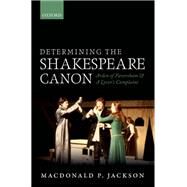Determining the Shakespeare Canon Arden of Faversham and A Lover's Complaint
, by Jackson, MacDonald P.- ISBN: 9780198704416 | 0198704410
- Cover: Hardcover
- Copyright: 8/19/2014
Editors of Shakespeare's Complete Works must decide what to include. Although not in the First Folio collection of 1623, The Two Noble Kinsmen and Edward III have now entered the canon as plays co-authored by Shakespeare. Determining the Shakespeare Canon makes the case for lifting Arden of Faversham, first published in 1592, over the same threshold. A wealth of evidence indicates that Shakespeare was wholly or largely responsible for several of its central scenes (constituting Act III in editions divided into acts), and that the domestic tragedy can thus be added to the mounting list of his dramatic collaborations. Shakespeare's beginnings as a playwright are due for reconsideration. The second half of this volume provides solid grounds for accepting that publisher Thomas Thorpe's inclusion of A Lover's Complaint within the 1609 quarto of Shakespeare Sonnets was justified. While A Lover's Complaint has long been part of the Shakespeare canon, according to most editors, the poem's authenticity has been vigorously challenged in recent years. Its status is crucial to how critics assess the authority of the quarto's ordering of sonnets and interpret the structure of the sequence as a whole. These two problems of attribution are each addressed in five separate chapters that describe the converging results of different approaches and rebut counter-arguments. Stylometric techniques, using the resources of computers and electronic databases, are applied and the research methodologies of other scholars explained and evaluated. Quantitative tests are supplemented with traditional literary-critical analysis.






